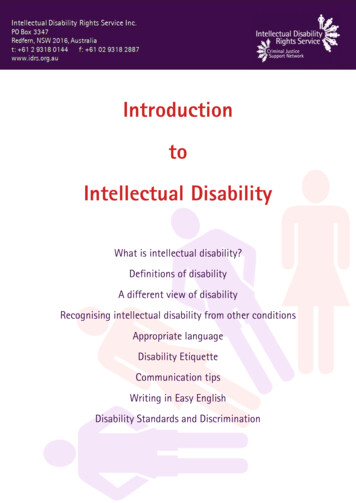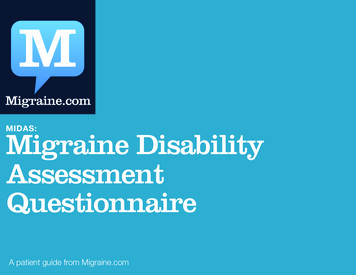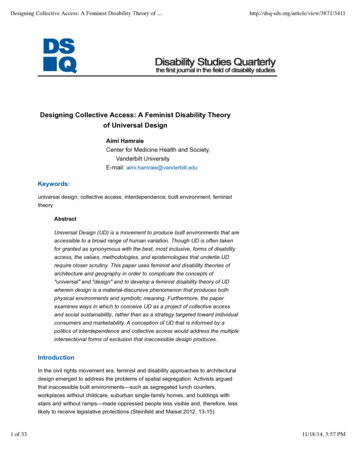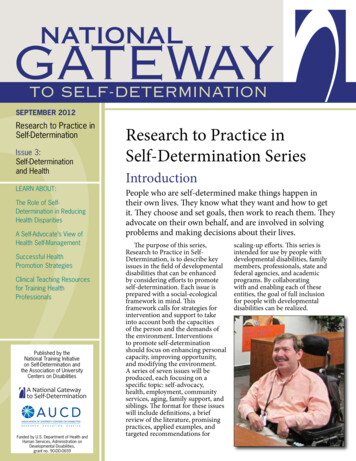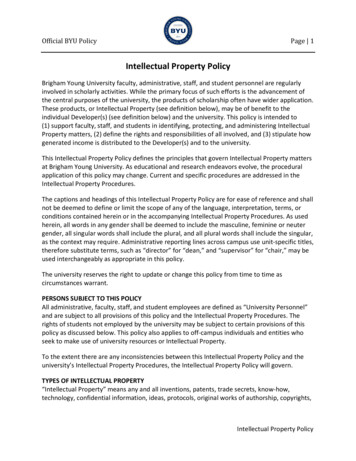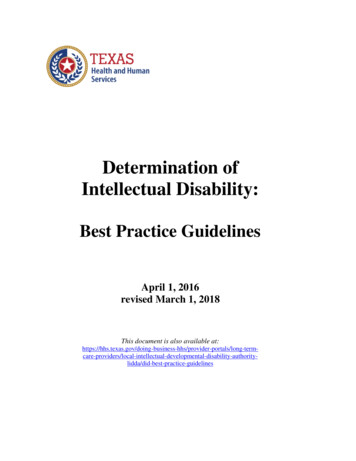
Transcription
Determination ofIntellectual Disability:Best Practice GuidelinesApril 1, 2016revised March 1, 2018This document is also available st-practice-guidelines
ContentsPurpose and Scope . 11. Diagnosis of Intellectual Disability. 1a) General guidelines . 1b) Guidelines for children . 22. Selection of Assessment Instruments and Tests. 3a) General guidelines . 3b) For individuals with blindness or other visual impairment . 4c) For individuals with a motor impairment . 5d) For individuals with a communication impairment . 5e) Use of brief assessment instruments and tests . 6f) When a standardized intellectual assessment cannot be successfully administered . 6g) Optional supplementary tests . 73. Validation of Previous Assessment and Test Results . 74. Interpretation of Assessment and Test Results . 8a) Intelligence tests . 8b) Adaptive behavior assessments . 85. Establishing Origination of ID during the Developmental Period . 96. Endorsement of a Previous Assessment . 10a) General guidelines . 10b) Endorsement of a previous assessment of a child . 117. Explanation of Findings . 118. Eligibility for Services Funded by General Revenue . 11a) Based on an intellectual disability . 11b) Based on autism spectrum disorder . 12c) Nursing facility residents . 129. Eligibility for the Intermediate Care Facility for Individuals with an IntellectualDisability and Related Conditions Program . 1310. Eligibility for the Home and Community-based Services and Texas Home LivingWaiver Programs . 1411. Eligibility for Community First Choice Services (non-waiver) with ICF/IID LOC . 1412. Court Ordered Determination of Intellectual Disability for HHSC Guardianship . 1413. Determination of Intellectual Disability Report Elements . 15Summary Chart of Eligibility Requirements for IDD Programs and Services . 17iRevised: March 1, 2018
Purpose and ScopeAs required by 40 Texas Administrative Code (TAC), Chapter 5, Subchapter D, DiagnosticAssessment, an authorized provider employed by or contracting with a local intellectual anddevelopmental disability authority (LIDDA) or state supported living center (SSLC) mustuse the Determination of Intellectual Disability (DID) Best Practice Guidelines (BPG).The DID BPG were developed by the Department of Aging and Disability Services (DADS)with input from authorized providers1 across the State. The DID BPG are designed to assistauthorized providers associated with a LIDDA or SSLC to conduct a DID or endorsementbased on current best practice. The DID BPG provide guidance on Texas-specific eligibilityfor intellectual and developmental disability (IDD) programs and services. The DID BPGare not intended to replace or supplant published clinical references except where noted.Adherence with the DID BPG will increase the quality and reliability of DID reports andendorsements. However, the Texas Health and Human Services Commission (HHSC) hasthe authority to require a new DID or endorsement to affirm eligibility for IDD services.1. Diagnosis of Intellectual Disabilitya) General guidelinesAn accurate diagnosis of an intellectual disability (ID) requires clinical judgment anddetermination based on three basic criteria:- impaired general intellectual functioning, defined as measured intelligence fallingtwo or more standard deviations below the mean for an individual’s age group;- impaired adaptive functioning, defined as the degree to which an individualdisplays deficiencies to meet the standards of personal independence and socialresponsibility expected of the individual’s age and cultural group; and- age of onset occurring during the developmental period, meaning before the18th birthday.The purpose of a DID is to determine eligibility for services; however, the assessmentshould always be approached as a clinical process which determines whether the person hasan ID or otherwise meets the criteria for IDD service eligibility. To that end, the assessmentmust be driven by sound clinical practices for differential diagnosis and consider mitigatingfactors (e.g., mental health issues, situational factors) that can affect the person’s cognitiveand adaptive functioning. Once an accurate diagnosis is achieved, then all eligibility criteriacan be applied and eligibility can be determined along with recommendations.1Associated with Tri-County Behavioral Healthcare, Texana Center, MHMR of Tarrant County, and the AlamoArea Council of Governments.1Revised: March 1, 2018
Given the unique challenges that may be encountered in the assessment of ID,authorized providers are reminded:- that assessment instruments and tests do not take into account the actual lifecircumstances of the individual being assessed (e.g., stressors in the individual’sdaily life);- that standardized intelligence tests must be administered in a controlled setting;- to observe any circumstances that deviate from a controlled and standardizedadministration of a test (e.g., lack of privacy and other distractions) and describesuch variations in the DID report with an opinion on the effect that these variablesmay have had on the results of testing; and- to take into consideration cultural differences and lack of opportunities toexhibit the assessed behavior when assessing adaptive functioning.b) Guidelines for childrenThe DSM-5 (page 41) recommends a diagnosis of “global developmental delay” (GDD) forchildren under the age of five years when the clinical severity level cannot be reliablyassessed during early childhood. Children to whom this diagnosis would apply are those whoare “ unable to undergo systematic assessments of intellectual functioning, includingchildren who are too young to participate in standardized testing.” The DSM-5 specifies thatthis category requires reassessment after a period of time. Assignment of a diagnosis of IDfor a child, especially a very young child, is often undesirable so this diagnostic option maymake sense. However, from a practical standpoint, this new diagnosis presents a challenge todetermining eligibility for HHSC services. For example, HHSC priority population served byLIDDAs includes children who are eligible for Early Childhood Intervention (ECI) services.When a child ages out of ECI services on the third birthday, the child is eligible to receiveservices funded by general revenue only if the child meets one of the other prioritypopulation criteria. A formal diagnosis of ID at that time would ensure continuity of criticalservices. Conversely, service disruption would result from even a temporary delay of the IDdiagnosis (e.g., until the child turns five years old).Based upon clinical judgment, an authorized provider has the discretion to “override” thediagnosis of GDD in favor of a formal diagnosis of ID for children under the age of five, ifcurrent measures of intellectual and adaptive functioning fall more than two standarddeviations below the mean for the child’s age and, given consideration of pertinentbackground variables, it is the conclusion of the authorized provider that current deficienciesrepresent a life-long condition.To avoid an unnecessary disruption, an authorized provider has a duty to the child toconsider relevant factors that can have a lasting impact on intellectual development. Someof the conditions and events strongly associated with a life-long pattern of intellectualsub-normality include:- presence of a genetic disorder known to be associated with a life-long patternof intellectual sub-normality (e.g., Down syndrome, Fragile X syndrome,Williams syndrome, Prader-Willi syndrome, Angelman syndrome);- prenatal exposure to alcohol or illegal substances;- physical illness experienced by the mother during pregnancy;2Revised: March 1, 2018
-lack of oxygen to the brain during labor or delivery;extremely premature delivery;childhood illness (e.g., meningitis) and some types of infections;onset of seizure activity at or shortly following delivery;inexplicable regression of attained milestones during the first 18 months of life; andother conditions associated with diminished intellectual capacity across the life span.If a child is three to four years of age and has experienced one of the events or conditionslisted above, it would be prudent to commit to an ID diagnosis for the sake of servicecontinuity. However, in recognition that IQ scores can be flexible and unreliable at such anearly age, a child who is diagnosed before age five should be reassessed with a fullcomprehensive assessment at age five, or earlier if the child demonstrates acquisition orloss of skills that affect general intellectual ability. The DID report should include arecommendation to reassess the child and offer guidance as to when reassessment shouldoccur.Assessing young children requires experience and specialized training. If an examinerdoes not have the required expertise and training, referral to a professional who istrained is recommended. If referral to a more experienced provider is not possible, theauthorized provider should:- consult with a colleague, teacher or other professional with relevant backgroundand training to ensure that the unique issues of children with developmentaldelays are considered;- reserve additional time for observation or review of reports of the child’s behaviorsand performance in a variety of settings (e.g., community, home, and school) ifnecessary;- establish rapport and adjust the testing schedule to the child’s attention span as needed;- recognize that a score based on subtests alone, remains a partial assessment ofcognitive ability that only approximates an IQ score;- interpret all test results with caution, especially if the child is age three or younger; and- explain any test modifications in the DID report since any deviation fromstandardized procedures can affect the validity of the scores obtained.2. Selection of Assessment Instruments and Testsa) General guidelinesThe selection of the proper test to assess a person’s abilities is an initial critical step inconducting a valid assessment. The most current versions of the Standards for Educationaland Psychological Testing (American Psychological Association), the Diagnostic andStatistical Manual of Mental Disorders (American Psychiatric Association), and IntellectualDisability: Definition, Classification and Systems of Supports (American Association onIntellectual and Developmental Disabilities) should be used as a reference for practice. Thesereferences discuss the importance of selecting valid, reliable tests; administering tests; andaddressing other critical considerations, such as test setting and instructions to the examinee.Measures of intelligence and adaptive functioning that are generally accepted for thediagnosis of ID must be established instruments with a body of published research thatsupports the reliability and validity of the test and its use with persons who have ID.3Revised: March 1, 2018
These instruments include, but are not limited to, current versions of the following: Intelligence Tests:- Wechsler Intelligence Scale for Children;- Wechsler Adult Intelligence Scale;- Stanford-Binet Intelligence Scale; and- Woodcock-Johnson Tests of Cognitive Ability. Adaptive Functioning Tests:- Vineland Adaptive Behavior Scales (VABS);- Adaptive Behavior Assessment System (ABAS);- Inventory for Client and Agency Planning (ICAP); and- Scales of Independent Behavior (SIB).These measures satisfy the professional standards for validity and reliability required fortheir use in the analysis of general intellectual functioning in persons being evaluated for ID.The same is true for standardized versions of these measures available for use withindividuals whose primary language is not English. An authorized provider should avoid theuse of the same intelligence test less than two years apart.b) For individuals with blindness or other visual impairmentWhen selecting an appropriate testing instrument for an individual with blindness or othervisual impairment, best practice dictates the use of a test normed on that population and onwhich the examiner has been trained. If an examiner does not have the required expertise andtraining, referral to a professional who is trained is recommended.If referral is not feasible, an authorized provider may opt to administer select subtests (e.g.,Wechsler Verbal Scales) from an array of assessment instruments in combination with anadaptive behavior instrument. If the individual’s skills preclude the use of a verbal subtest,an authorized provider may use a rating scale (e.g., Developmental Profile). The HapticIntelligence Scale may be an option for an adult who reads Braille (even if the authorizedprovider does not). Finally, although not recommended as the first choice for any initialevaluation, the current version of the Slosson Intelligence Test contains materials andinstructions with adaptations for use with persons who are visually impaired.Regardless of the assessment instrument used, an authorized provider who has limitedtraining and expertise should:- consult with a colleague, teacher or other professional with relevant backgroundand training to ensure that the unique developmental issues of an individual witha visual impairment are considered;- reserve additional time for observation or review of reports of the individual’sbehaviors and performance in a variety of settings (e.g., community, home, school,work) as necessary;- recognize that a score based on subtests alone remains a partial assessment ofcognitive ability that only approximates an IQ score;4Revised: March 1, 2018
-interpret all test results with caution if using a test that was not normed onindividuals with vision impairments; andexplain any test modifications in the DID report since any deviation fromstandardized procedures can affect the validity of the scores obtained.c) For individuals with a motor impairmentWhen selecting an assessment instrument to use with an individual with a motorimpairment, the examiner should follow the guidance provided above for visual impairment.Global intelligence measures have subtests that require the use of fine motor skills. Forindividuals with impairment of fine motor or hand-eye coordination, use of verbal subtestsonly may suffice. The severity of motor impairments may not be evident until tests areadministered. Rationale for not administering, or for not scoring motor subtests, should bedelineated in the DID report.d) For individuals with a communication impairmentWhen selecting assessment instruments to use with an individual who has a communicationimpairment an examiner should first carefully determine the person’s communication skills,hearing ability and preferred style of communication. For example, a person may not exhibitverbal language skills, but may be able to point reliably, respond using a communicationboard or gesture yes/no through head movements or eye gaze. In addition, the examinershould identify if the person understands language (receptive skills) but has difficultyproducing language (expressive skills).If a person cannot express verbal language but is able to understand verbal directions, theperformance or nonverbal sections of a comprehensive test of intelligence may provide avalid estimate of intellectual ability. If a person is unable to understand verbal instructions, atest for hearing impaired individuals, such as the Leiter International Performance Scalemay be appropriate to use. In all cases, the authorized provider should consult the testmanual to determine if using a portion of a test is endorsed by the test developer or if themanual contains specific recommendations regarding the use of the test with peoplesuspected of ID or ASD. Any variations from usual testing processes, such as extending thetest over several sessions or using yes/no choices to answer questions, should be explained inthe DID report.Similar considerations may be necessary when no test is available in the individual’sdominant language. In these situations, an interpreter may be used if allowed by the testdevelopers. If an interpreter is not available or is not advised in the test manual, it may bejustified to use the most current version of a nonverbal assessment instrument, such as theWechsler Nonverbal Scale, the Leiter International Performance Scale, the UniversalNonverbal Intelligence Test (UNIT) or the Comprehensive Test of Nonverbal Intelligence. Therationale for selecting a nonverbal measure should be explained in the assessment report.5Revised: March 1, 2018
e) Use of brief assessment instruments and testsAuthorized providers are discouraged from using brief tests of intelligence to establish anindividual’s initial eligibility for IDD programs. However, in limited situations an exceptionmay be warranted. For example:- the individual presents with a well-established, documented testing historybased on broad-based batteries and brief test results are consistent with testinghistory;- the individual participated in multiple cognitive tests while in school thatyielded consistent scores, yet a more current IQ score is required;- a particular broad-based battery of tests does not have sufficient “floor” or basallevel (i.e., insufficient number of items) to adequately evaluate an individual’strue mental abilities; or- an individual does not have adequate attention and concentration to tolerate a fullscale measure and their adaptive functioning and history are consistent withintellectual disability.If an authorized provider uses a brief IQ test (e.g., Kaufman Brief Intelligence Test or SlossonIntelligence Test) or an abbreviated battery (e.g., Wechsler Abbreviated Scale of Intelligenceor Stanford-Binet Abbreviated Battery), the authorized provider must explain the rationalefor this choice and justify its use in the DID report. However, any significant change(including a decline or improvement) in functioning since the last evaluation would ruleagainst the use of a brief test.f) When a standardized intellectual assessment cannot be successfully administeredIf an individual’s intellectual functioning is severely or profoundly impaired, it may benecessary to use a developmental rating scale (e.g., Developmental Profile) in an effort toprovide a profile of abilities. Even in cases in which age-appropriate norms are not available,the use of age equivalents may have merit in depicting an individual’s range of competenciesand deficiencies. Age equivalents are norm-referenced scores, but they differ from standardscores and percentiles in that their purpose is not to indicate where the individual’s raw scorefalls in relation to the distribution of scores for other individuals of the same age. Rather, ageequivalents indicate the age level at which the average person in the population performs thesame skill as the individual who is being assessed. Age equivalents should be interpretedwith caution to avoid suggesting that an individual “is like” someone at a youngerchronological age and inadvertently promote situations in which the individual is treated as ifhe or she was a child. Age equivalents should be explained in the context of specific skills,rather than as a conclusion about general functioning.In some situations, an individual’s limitations may be so extensive that a full scale IQscore cannot be obtained from a standardized intelligence test. In these situations, anestimate of the individual’s IQ score, or, IQ score equivalent should be stated with clinicaljustification. For example, if an individual’s ability to comprehend oral instruction orvisual demonstration is not adequate for a formal appraisal of general intellectualfunctioning, the use of an Adaptive Behavior Composite (e.g., provided by the VABS)may serve as an estimate of the individual’s intellectual functioning when accompaniedby a clinical justification explained in the DID report. However, not all measures ofadaptive behavior (e.g., ABAS, ICAP, and SIB) are appropriate for establishing an IQscore equivalent.6Revised: March 1, 2018
g) Optional supplementary testsAbsent a broad-based intellectual battery, the use of supplementary tests allow for theconstruction of a more detailed profile to reflect an individual’s unique set of relativestrengths and weaknesses. When assessing individuals who are moderately or severelyintellectually impaired, it can be advantageous to employ supplementary tests to probeother related areas of functioning, such as:- expressive language development (e.g., the current versions of the ExpressiveVocabulary Test or Expressive One-Word Picture Vocabulary Test);- receptive language development (e.g., the current versions of the PeabodyPicture Vocabulary Test or Receptive One-Word Picture Vocabulary Test);and- visual-motor integration (e.g., the current versions of the Beery-BuktenicaDevelopmental Test of Visual-Motor Integration or Bender-Gestalt Test).The examiner should also consider that while a person may be reported to be “nonverbal,”this may be true for oral expression and not written expression. In those situations, anauthorized provider should allow an individual the option to respond by using an electronictablet, a communication board, or pen and paper. Deviations from standardizedadministration or the use of a nontraditional approach, such as alternate response modalitiesor an adaptive measure in lieu of an intelligence test, must be explained in the DID report.If an individual has a mild intellectual impairment, it is also often advantageous to employsupplementary tests to probe related abilities, such as academic achievement, in an effort tocompare and contrast general intellectual functioning with functional scholastic skills. Testssuch as the Wide Range Achievement Test and the Woodcock-Johnson Achievement Batteryare well- normed examples.Supplementary test information may be available through academic records. The authorizedprovider may request reports from an individual’s school records to obtain a fuller pictureof the person’s skills and abilities. While these tests may not contribute to a diagnosis of ID,they can provide valuable information for determining age of onset and for developingrecommendations that may inform subsequent treatment planning and service deliverydecisions.3. Validation of Previous Assessment and Test ResultsValidation refers to accepting the results of one or more specific assessment measures thatwere administered by another professional. In trying to decide whether or not to validateprevious test results, an authorized provider must consider:- how old the testing is;- developmental changes that have occurred since the testing; and- if the instrument used was appropriate to the individual.The current DID report must include a statement by an authorized provider attesting to thevalidity of a previous test. A previous assessment or test is not eligible for validation ifcompleted when the individual was under age 22 and the testing was done more thanfive years ago.7Revised: March 1, 2018
4. Interpretation of Assessment and Test Resultsa) Intelligence testsGeneral intellectual functioning is a multi-faceted concept. As described in the Diagnosticand Statistical Manual of Mental Disorders, Fifth Edition (pages 33 & 37) and the User’sGuide: Intellectual Disability: Definition, Classification and Systems of Support (pages 15), intellectual functioning consists of the ability to reason, make plans, solve problems,think abstractly, comprehend complex ideas, make judgments, and learn from instructionand experience.While formal diagnosis of ID requires the use of a properly constructed and administeredcognitive or intellectual measure, an authorized provider also must exercise clinicaljudgment to interpret the obtained scores in reference to the assessment instrument’sstrengths and limitations, age of norms used for validity, and other factors (e.g., practiceeffect, fatigue, difficulty sustaining focused attention, competing idiosyncratic thoughts).Additionally, the full scale IQ score is a composite of multiple subtests. For example, if thereis statistically significant variability in an individual’s scores on particular subtests due toknown clinical conditions (e.g., traumatic brain injury), the full scale IQ score may not be avalid summary measure of overall intellectual functioning. It is important that the authorizedprovider describe relative cognitive strengths and weaknesses when interpreting thesederived scores in order to provide an accurate depiction of functioning. This interpretation isuseful for making recommendations and planning.Another variable in the interpretation of test results is the “standard error ofmeasurement” or SEM. Developers of standardized tests provide information about theSEM to reflect the reliability (i.e., precision) of the scores derived from a test. The SEMis the variation around a “true score” (i.e., the score that would be obtained if the test hadperfect reliability). Although clinical practice allows and encourages the use of SEM andsound clinical judgment, the DID assessment process is first and foremost aneligibility assessment for HHSC services. The State has established a fixed IQ cut-offscore to determine eligibility for IDD programs. Infrequently, an authorized provider mayfind an individual does not meet eligibility to receive those services even though theindividual has a diagnosis of ID based on DSM-5 criteria, including an IQ score higherthan service eligibility criteria. Nevertheless, an authorized provider who conductseligibility determinations must apply HHSC eligibility criteria to conclude that anindividual has a qualifying diagnosis of ID under the agency’s rules. The authorizedprovider should also be prepared to explain the criteria for diagnosis versus eligibility.b) Adaptive behavior assessmentsCompared to previous versions, the DSM-5 places a greater emphasis on adaptivefunctioning in the diagnosis of ID (and a corresponding decreased emphasis on standardizedIQ tests) in two ways. First, the manual states that a diagnosis should be “based on bothclinical assessment and standardized testing of intellectual and adaptive functions” indicatingthat exclusive reliance on standardized tests is inadequate. Second, the DSM-5 (pages 33-36)is the first edition to classify level of severity based on adaptive functioning rather than IQscore. The DSM-5 explains that “the various levels of severity are defined on the basis ofadaptive functioning, and not IQ scores, because it is adaptive functioning that determinesthe level of supports required.” In other words, the DSM-5 recognizes that adaptive8Revised: March 1, 2018
functioning has greater practical significance because it is a better indicator of theindividual’s ability to function in society. Title 40 TAC Chapter 5, Subchapter D (DiagnosticAssessment), §5.153, defines the term “adaptive behavior” as “the effectiveness with ordegree to which an individual meets the standards of personal independence and socialresponsibility expected of the individual’s age and cultural group as assessed by astandardized measure.”A standardized measure in adaptive behavior is used to determine if an individual haslimitations and based on their significance to assign an adaptive behavior level (ABL). Inaccordance with 40 TAC §5.155, an authorized provider must assign an ABL in the DID.The State requires an ABL assignment based on the following levels and descriptors:- ABL I “mild” deficits or limitations in adaptive skills;- ABL II “moderate” deficits or limitations in adaptive skills;- ABL III “severe” deficits or limitations in adaptive skills;- ABL IV “profound”2 deficits or limitations in adaptive skills; and- ABL 0 Less than “mild” deficits or limitations in adaptive skills.When determining th
4 Revised: March 1, 2018 These instruments include, but are not limited to, current versions of the following: Intelligence Tests: -Wechsler Intelligence Scale for Children; -Wechsler Adult Intelligence Scale; -Stanford-Binet Intelligence Scale; and -Woodcock-Johnson Tests of Cognitive Ability. Adaptive Functioning Tests:
